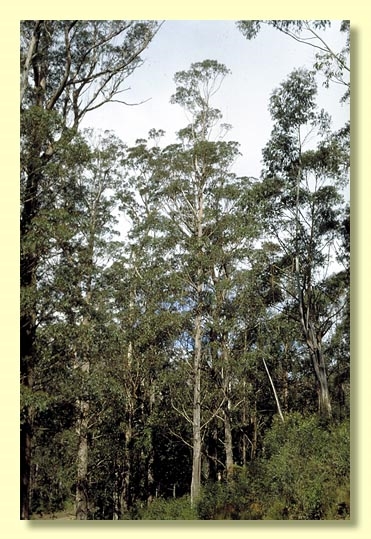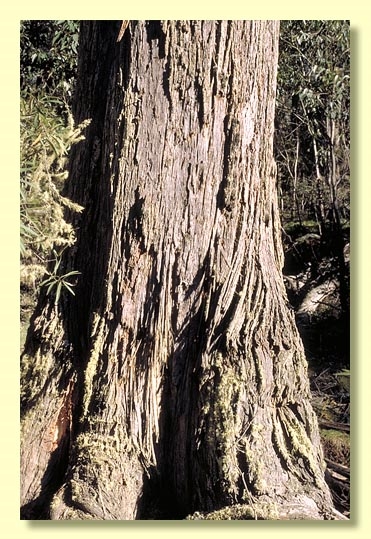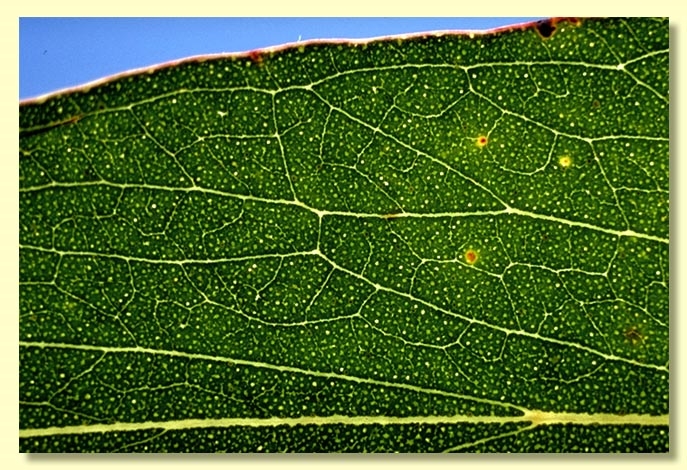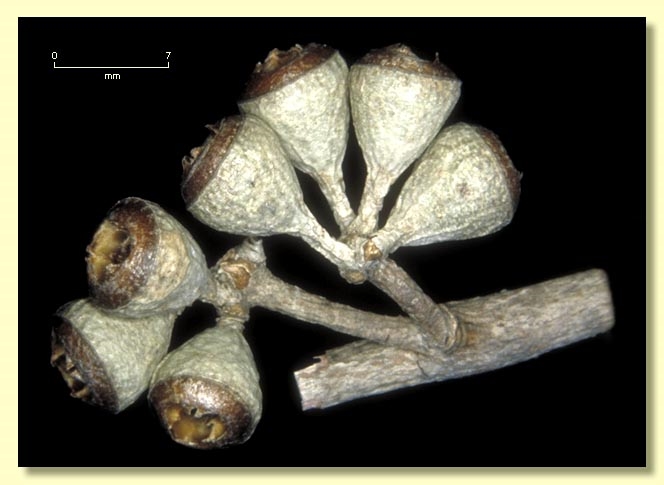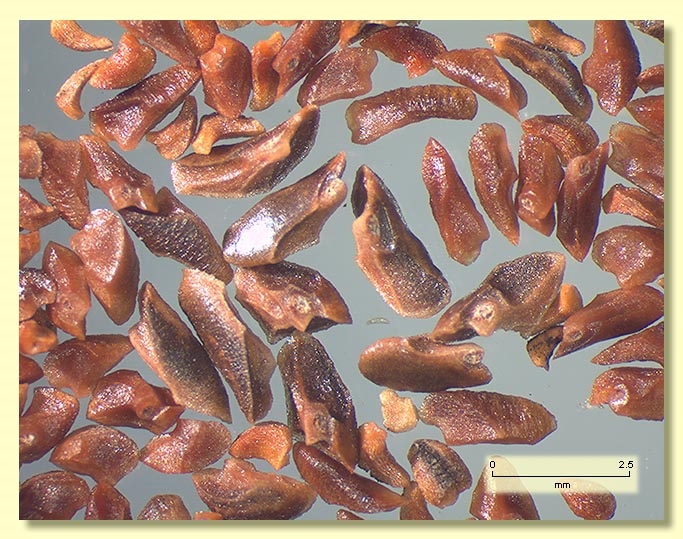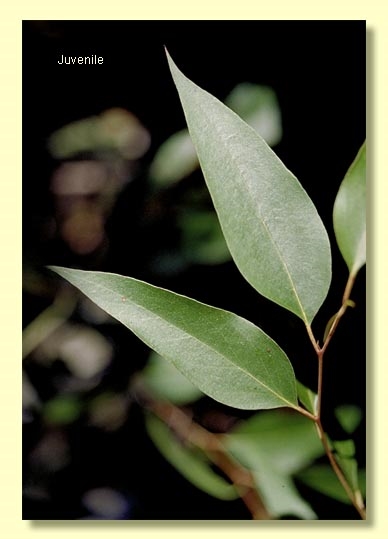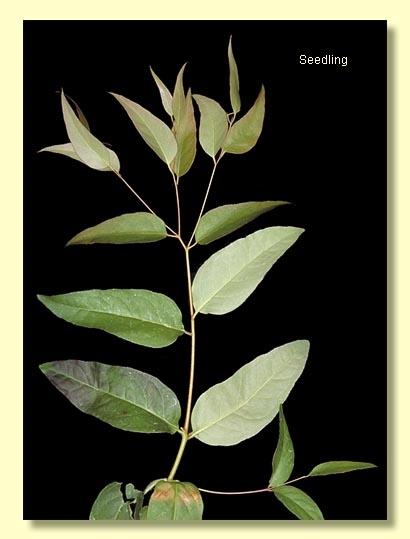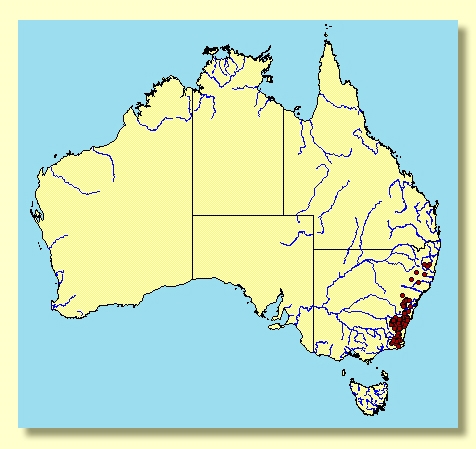Euclid - Online edition
Eucalyptus fastigata
Eucalyptus | Eucalyptus | Eucalyptus | Regnantes
Bark rough on trunk and larger branches, fibrous or stringy, often furrowed, grey or brown; smooth bark of branches white, cream, orange, grey or brown, with ribbons of decorticated bark conspicuous in the crown.
Juvenile growth (coppice or field seedlings to 50 cm): stem rounded in cross-section, usually smooth; juvenile leaves petiolate, at first opposite and broadly elliptic to ovate, soon becoming alternate, broadly lanceolate to falcate, 4.5–12 cm long, 1.8–5 cm wide, bases rounded to oblique, discolorous, green.
Adult leaves alternate, petiole 1–1.7 cm long; blade lanceolate to falcate, 7–20.5 cm long, 1.5–3.6 cm wide, base oblique to tapering to petiole, concolorous, or slightly discolorous, usually glossy, green, side-veins acute or parallel, sparsely reticulate, intramarginal vein parallel to and well removed from margin, oil glands island.
Inflorescence often of paired umbels in the axils but may be single also, unbranched, peduncles 0.4–1.4 cm long, buds 11 to 15 or more per umbel, pedicels 0.1–0.5 cm long. Mature buds obovoid to ovoid, 0.3–0.6 cm long, 0.2–0.3 cm wide, green to yellow, scar absent, operculum slightly beaked to conical or rounded, stamens irregularly flexed, anthers reniform to cordate, versatile, dorsifixed, dehiscing by confluent slits (usually), style long, stigma tapered, locules 3 or 4, the placentae each with 2 vertical ovule rows. Flowers white.
Fruit pedicellate rarely sessile (pedicels 0.1–0.5 cm long), obconical or pyriform, 0.5–0.9 cm long, 0.4–0.8 cm wide, disc raised-convex, oblique or annular, or disc level, valves 3 or 4, exserted or near rim level.
Seeds brown, 2–3.5 mm long, pyramidal or obliquely pyramidal, dorsal surface smooth, hilum terminal.
Cultivated seedlings (measured at ca node 10): cotyledons reniform; stems rounded in cross-section; leaves shortly petiolate, opposite, broadly elliptic and discolorous for ca 3 to 5 nodes then becoming alternate, ovate to broadly lanceolate, 6–11 cm long, 2–5.5 cm wide, base tapering to oblique, apex pointed, glossy, mid-green.
Flowering has been recorded in January, February and December.
A medium-sized to tall, stringybarked tree with smooth-barked branches and green leaves growing in mountains in New South Wales and Victoria. It occurs on heavy, red or chocolate-coloured soils on well-watered sites of the eastern margins of the Northern Tablelands, e.g. Point Lookout, near Ebor and Yarrowditch, south through the the Blue Mountains, e.g Mt Tomah, Mt Wilson, Oberon and extensively on the eastern ranges and escarpment of the Southern Tablelands, e.g. Mittagong, Sassafras, Monga, Big Badja, Gourock Range, Brindabella Range, Kybean Range, Tanatwangolo, Mt Darragh, Bombala, and just into eastern Victoria, e.g. Errinundra Plateau.
E. fastigata, like its close relative E. regnans, often has paired axillary inflorescences, but differs from that species in having rough bark over the whole trunk and fruit with a raised disc, compared to the slightly sunken disc in E. regnans. The branches are smooth and the crown is usually ribbony, which distinguishes it from E. obliqua, the other tall green-leaved ash species of similar wet forests. The smooth, bright green juvenile leaves held horizontally distinguish it from the stringybarks, and the green-leaved ash characters from the blue-leaved ashes.
Eucalyptus fastigata belongs in Eucalyptus subgenus Eucalyptus section Eucalyptus series Regnantes, because of the following combination of characters: tall tree habit, fibrous rough bark (over whole trunk), alternate, green juvenile leaves, sparsely reticulate adult leaves, paired axillary inflorescences with pedicellate buds having only one operculum and reniform anthers, ovules in two rows, and ± pyramidal seeds.

